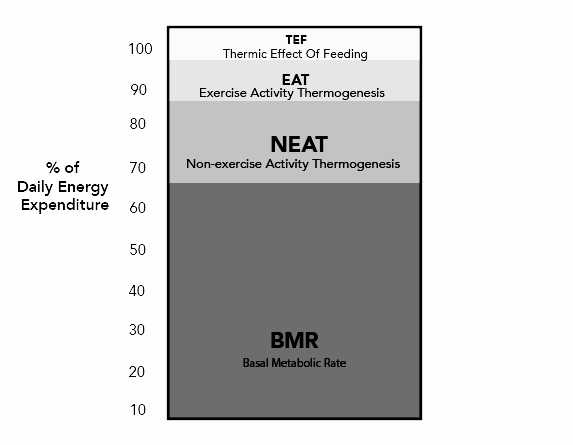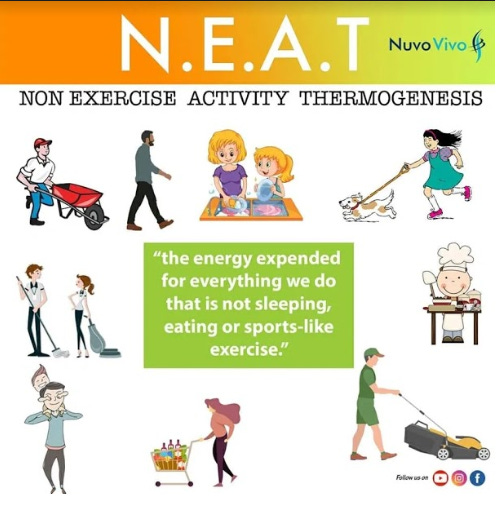What Determines Calorie Burn?
You don’t have to count calories to lose fat. But calories do count whether you count them or not. And while we don’t ask our 1 on 1 clients to count calories, we still believe in the laws of thermodynamics. Nutritionally, the goal is to find simple ways to gravitate toward lower calorie options while still feeling full on a day to day basis. This helps address the “calories in” side of the equation.
When people think of “calories out” they usually think it’s mostly exercise. But the reality is exercise generally only accounts for only 5-10% of your daily calorie burn.
The scientific term for “calories out” is Total Daily Energy Expenditure, also known as TDEE. This is the number of calories your body burns in total throughout any given day. It will vary based on your height, body mass, daily exercise, occupation, the foods you eat and your intrinsic health and hormone status.
A calorie is a measure of heat energy. 1 calorie = amount of energy needed to raise the temperature of 1 gram of water by 1 °C.
If you eat more calories than your TDEE consistently, you will gain fat. If you eat fewer calories than this number consistently, you will lose fat. It sounds simple. The problem is, we don’t know exactly what this number is. We can take an educated guess based on your age, height, and weight and activity level but it will still vary individually.
TDEE can be broken down into individual components.
Your Total Daily Energy Expenditure (TDEE) = Basal Metabolic Rate + Thermic Effect of Food + Exercise Activity Thermogenesis + Non-Exercise Activity Thermogenesis
These may not mean anything right now, but we’ll discuss each one and how to improve it. We’ll also discuss where you get the most leverage to see results in your own life.
Basal Metabolic Rate
The largest component of your TDEE is your Basal Metabolic Rate (BMR). This is the total number of calories burned by simply existing and staying alive during a day. It accounts for only the most basic essentials to life like breathing and blood circulation. These are highly demanding tasks and account for over 60% of your total energy burn for the day.
This is formally tested by having individuals lie down in a machine for several hours. They don’t move or eat and the device captures the amount of oxygen in and carbon dioxide they breathe out. Fun fact: Fat loss is lost via carbon that you breathe out over time (we’ll save more on that for a more chemistry-centric post).
It’s not realistic to accurately determine your BMR at home. Fortunately it’s not necessary. This number can be estimated using formulas online but will vary widely.
When people say they have a “slow metabolism” this is the number they are talking about. It is affected primarily by your age, body mass, body composition and overall hormone health. But individuals of the same size and age can still have a 7-9% difference in BMR.
While it accounts for the largest percentage of our TDEE it is actually where we have the least ability to make an impact in the short term. Adding muscle mass, being more active and improving your metabolic and hormonal health can help your body burn more calories at rest, but for most people this number will remain within a limited range.
Fortunately even a low BMR doesn’t have to prevent you from reaching your goals because you get more say in other areas.
Thermic Effect of Food - (TEF)
This is the number of calories burned by digesting various macronutrients. Protein has a thermic effect of around 25%. This means that from the 4 calories in every gram of protein, your body will burn 1 calorie just by digesting it.
It takes the same amount of energy to digest carbs as it does fats, but fats have 9 calories per gram compared to carbs with 4 calories per gram. Because of this, carbs have a thermic effect of around 10% and fats only around 5%. For every 10 calories of carbs or every 20 calories of fat, your body will burn 1 calorie digesting.
You can see where the foods you eat have an impact over time. Maximally TEF could contribute up to 15% of your daily calorie burn. While it’s never going to be the primary player, choosing leaner options for your protein sources and picking more protein over carbs can lead to an additional 100-200 calories burned everyday just by eating protein. That equates to 15 lbs of calorie burn in a year and is the equivalent of doing 15 minutes of additional cardiovascular exercise every single day.
Exercise Activity Thermogenesis - (EAT)
This is exactly what it sounds like; the total calories burned specifically from exercise related activities. Maybe this is cardio on a bike. For others it’s a weight training session. Either of these will burn calories. While some exercise burns more calories than others they all count toward your Exercise Activity Thermogenesis total.
Consistent exercise has been shown to be helpful in both achieving and maintaining weight loss. That said, we believe it is best to view exercise activity thermogenesis as a bonus. This means disconnecting from the calorie burn with your workouts. There are a couple reasons for this.
#1 - Most workouts significantly overestimate calories burned by several 100 calories per session.
#2 - Your body will partially compensate for this extra calorie burn during the rest of the day, partially negating the effects. For example, if you workout you tend to fidget less as your desk or your heart rate adapts to lower rates.
#3 - It creates a reward system that can be a slippery slope. It takes an hour to burn 500 calories and just seconds to eat them again.
Lift weights to build muscle. Do cardio to improve heart and mental health. Calorie burn is a bonus.
Non-Exercise Activity Thermogenesis (NEAT)
Non-Exercise Activity Thermogenesis is the additional calories burned from movement that has nothing to do with exercise. This includes voluntary actions like occupation-related movements, daily steps, cleaning the house, taking the stairs, playing with the kids or carrying groceries.
It’s also the involuntary movements like fidgeting at the desk or shivering in the cold. Despite not being the largest percentage of calorie burn, this is arguably the most important number since it’s one we can control at the individual level. You can’t immediately improve your BMR. But you can improve your NEAT by living an active lifestyle.
People of similar sizes could theoretically have a NEAT number that is 2000 calories different depending on their lifestyle.
-Person A walks 1000 steps per day while sitting at a desk.
-Person B works an active job in construction, plays pickleball on weekends and takes nightly walks with his wife.
They will burn a drastically different number of calories per day despite no formal exercise or differences in baseline metabolism. It’s all NEAT-related.
This is an extreme example but highlights the point. Increasing your step count, taking the stairs, and living an active lifestyle will burn as many or more calories in a day than adding structured exercise into the mix.
And if you think your metabolism is slow, it’s where you have the most margin to close the gap.In individuals with a sedentary lifestyle NEAT accounts for <10% of TDEE. But for those highly active it can be up to 50% of total calorie burn. In the majority of people, NEAT consistently makes up a greater daily calorie burn than exercise.
You won’t control every aspect of your NEAT as your occupational demands and schedule may be set for you but having leisure activities tied to movement, increasing your daily step count and finding ways to stay somewhat active while working a desk job are where you can make an impact.
Summary:
Most people spend much of their attention being concerned about their metabolism (BMR). The reality is that while this number matters, we have little control over it.
You are better served focusing your efforts toward the areas where you have some leverage. Eat more protein to increase the thermic effect of food (TEF), walk more, find active hobbies to improve Non-Exercise Activity Thermogenesis (NEAT) and find a sustainable approach to exercise to increase Exercise Activity Thermogenesis (EAT).
Collectively these combined with the right nutritional approach will lead to fat loss, body composition improvements and overall better health outcomes.
Until Next Time,
Brett
Brother2Brother
P.S. “What’s the best way to cook alligator? … a croc-pot.”
P.P.S. You have to see this incredibly inspiring video from Joe. He sent us this after climbing 14,000 feet this week in Colorado.

Hope that gets you guys as fired up as us! Have a great weekend.

